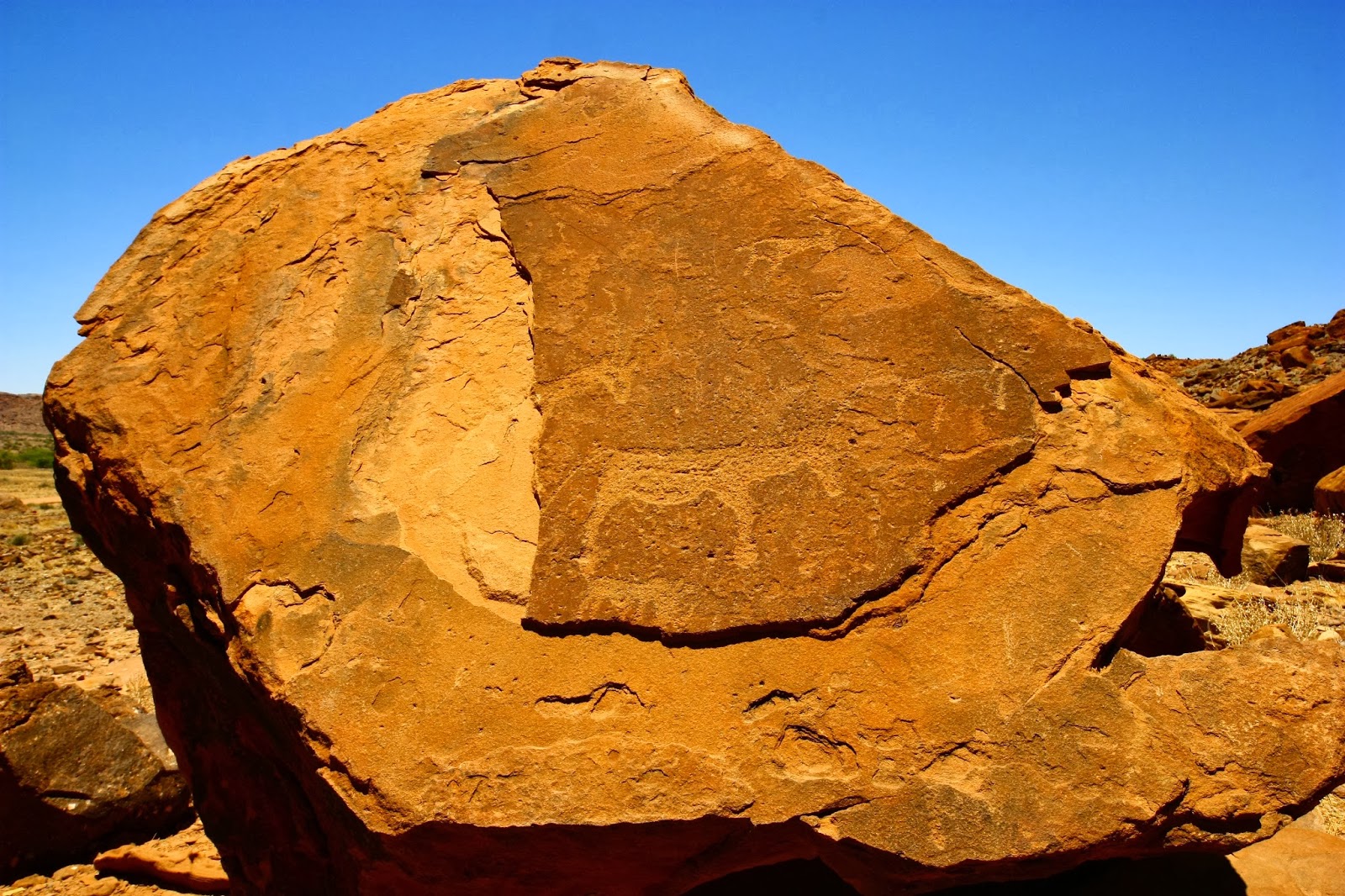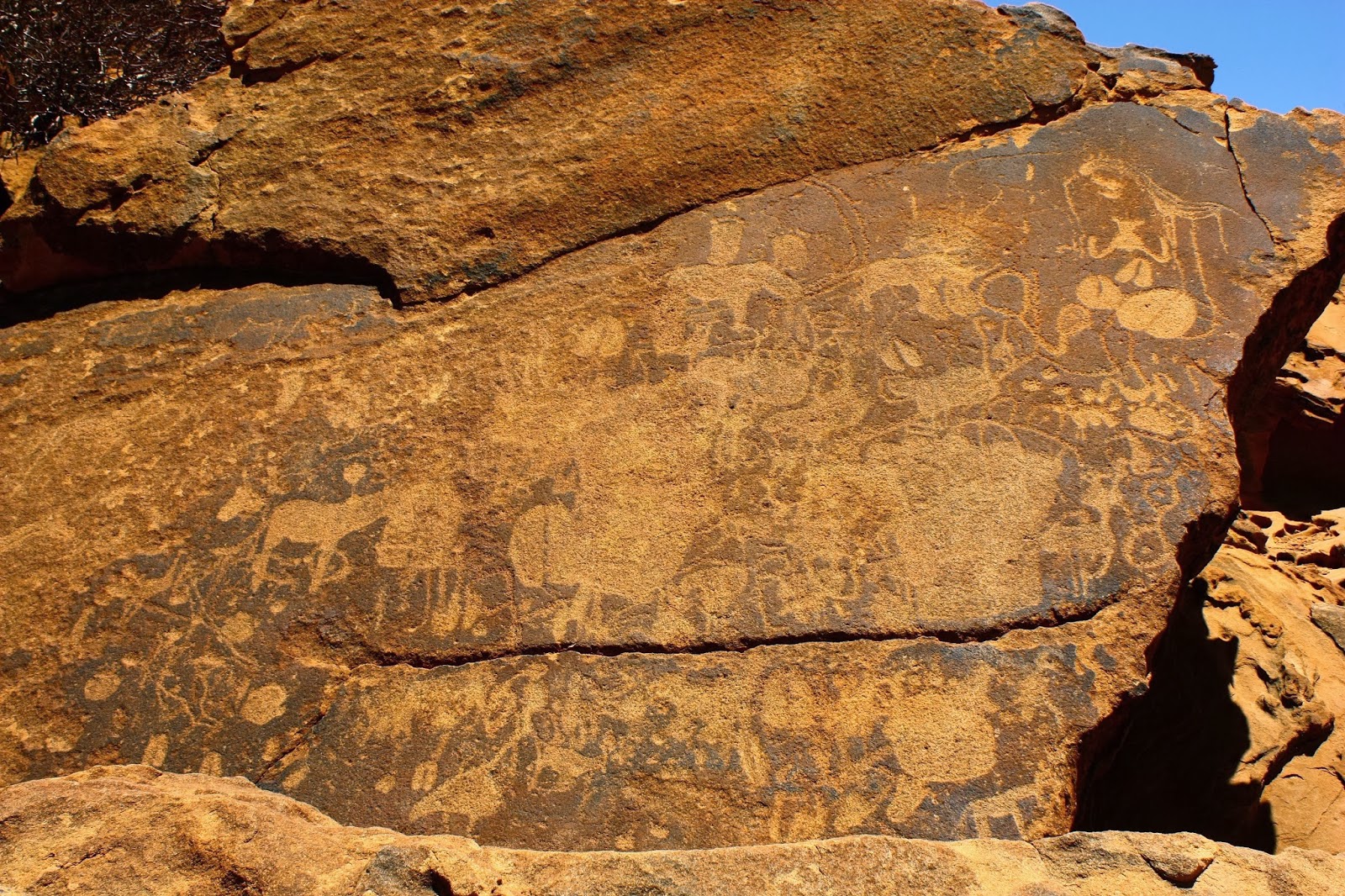Day 4 began and ended in Damaraland, which did not involve much driving--yay! The big hit of the day was the San art rock engravings that date from 2,000 to 6,000 years old. The site is called Twyfelfontein, which means 'doubtful spring' because the amount of water coming out was considered to be too small for permanent human occupation. However, the spring has continued to bubble constantly over the past 65 years or so--the time of the first white occupation following World War II. Yes, the first white occupation was after WWII, wow--that was the time period when emigrated Germans and Afrikaners forcibly removed the native people from this land.
Before the sun arched too high Jennifer and I climbed to the top of a large ridge line, forging a hiking trail of our own, in order to look out over the plains. This was one of our best panoramas. You will note the white and black surfaces that look scorched from fire, but are actually the color of exposed rock. The white rocks are quartz and the black rocks are a volcanic intrusion that is similar to basalt.
 |
| These vertical rock columns are called the organ pipes--you can see why--and were exposed through a stream eroding the landscape and cutting through the rock. |
 |
| This is an interesting rock formation--next to the basalt intrusion on the left we have a different type of mineral form that I haven't identified. It is shiny and gray and flakes apart in thin planes. If you know something about this rock/mineral please let me know. It seems to have formed in the cooling process after the magma intrusion. |
 |
| This is the "burnt mountain" that is actually just exposed rock. |
 |
| A rock with significant iron deposits--you can tell from the orange rust. |
 |
| Very interesting to note that the white sections of this picture are actually exposed white quartz. |
 |
| If you look closely you can see our rental truck in this picture! |
 |
| The beginning of our guided tour through the San art rock engravings. |
 |
| The lion at the bottom middle of this engraving is very significant because it tells us a lot about the spiritual beliefs of the San people. San had a deep connection with nature and believed that they would turn into an animal after death. Shamans or spiritual leaders were believed to be able to cross into the spiritual world of animals during meditation and the lion's tail is an indication that a shaman has taken the form of a lion. The five-dotted symbol at the end of the lions tail symbolizes a person's hand--one of the only human symbols on the rock engravings. The only other human symbols or figures in the paintings are the carved feet that you see five pictures below. |
 |
| Note that this giraffe also has five points on its head--also an indication that this is a shaman or person in the form of an animal. |
 |
| Guess what this is... I'll tell you in the caption below. |
 |
The carving above is a penguin! San people traveled all the way to the coast during their travels--hundreds of miles away across vast deserts.
This rock engraving is actually a map--the circles denote watering holes. A watering hole that is permanent has a groove dug in the middle of the circle. A watering hole that dries up at different periods has no groove in the middle--it just looks like a circle. |
 |
| This is thought to be a practice rock that people used quite often. Some interesting tracks are seen in the top right--three different types of grazers (I don't know which ones). |
 |
| Here are the only carvings of an actual human body part--no other figures of people are present on the rocks at this site! |
 |
| This is the first white dwelling in the area that was built following the second world war. It was used as a farm for a period of time, then abandoned after a period of time. |
 |
| This is the 'cove' of rock that housed a spiritual place for the San people of this area. We kept discussing how safe it felt to be completely surrounded by rock and looking out towards the valley's entrance. |
 |
| Time for a braai! I finally figured out how to use one of these things successfully--there is definitely an art to building the right fire and placing the meat in the grid. |
 |
| This was a migrating bird that ate Mopani Tree Worms. It is called a yellow-billed hawkbill. When it flew it reminded Jennifer and me of a Pileated Woodpecker. |























No comments:
Post a Comment